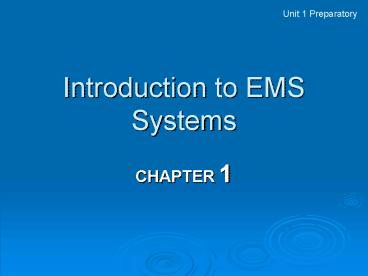Introduction to EMS Systems - PowerPoint PPT Presentation
1 / 29
Title:
Introduction to EMS Systems
Description:
A network of resources to provide emergency care and transport to ... EMT-Paramedic. EMT-Intermediate. EMT-Basic. First Responder. Roles and Responsibilities ... – PowerPoint PPT presentation
Number of Views:236
Avg rating:3.0/5.0
Title: Introduction to EMS Systems
1
Introduction to EMS Systems
Unit 1 Preparatory
- CHAPTER 1
2
Introduction to EMS Systems
- The EMS System
- Components of the EMS System
- Activating the EMS System
- In-Hospital Care System
- Medical Oversight
- Roles and Responsibilities of the First Responder
- First Responder Skills
- Equipment, Tools, and Supplies
3
The EMS System
- A network of resources to provide emergency care
and transport to victims of sudden illness and
injury.
4
The Emergency Scene
5
Recognition of Accident and Activation of EMS
6
EMS Dispatch
7
Arrival of First Responders
8
Care Given at the Scene
9
Arrival of Additional EMS
10
Care During Transport
11
Transfer to Hospital Emergency Department
12
Components of the EMS System
- Human Resources
- Medical Oversight
- Communications
- Facilities
- Transportation
- Resource Management
- Regulation and Policy
- Public Education
- Evaluation
13
Activating the EMS System
- Enhanced 9-1-1
- 9-1-1
- Non 9-1-1
14
In-Hospital Care System
- Emergency Department
- Specialty Facilities
- Trauma Centers
- Burn Centers
- Pediatric Centers
- Hospital Personnel
- Physicians
- Nurses
- Allied Personnel
15
Medical Oversight
- The First Responder may be a designated agent of
the physician. Care rendered may be considered
an extension of the medical directors authority.
16
Medical Oversight
- A formal relationship between the EMS providers
and the physician responsible for the prehospital
emergency medical care provided in a community.
17
Medical Direction Given by On-line Orders
18
Medical Oversight
- Indirect Medical Control
- System Design
- Protocols
- Education
- Quality Management
19
Levels of Training
- EMT-Paramedic
- EMT-Intermediate
- EMT-Basic
- First Responder
20
Roles and Responsibilities
- Personal health and safety
- Neat, clean, and professional appearance
- Competency in knowledge and skills
- Caring attitude
- Maintain composure
21
Patient-Related Duties
- Size up the scene.
- Find out what is wrong with the patient.
- Lift or move the patient only when it is
necessary. - Transfer the patient and patient information.
- Protect the patients privacy and maintain
confidentiality. - Be the patients advocate.
22
Skills ((START HERE))
- As a First Responder, you should be able to
- Assess and control the scene of a simple
incident. - Gain access to patients.
- Evaluate a scene for safety.
- Properly use all items of personal safety.
- Gather information from patients and bystanders.
- Conduct a patient assessment.
- Relate signs and symptoms to illnesses and
injuries. - Determine vital signs.
- Document.
- Perform airway management.
- Perform Cardiopulmonary Resuscitation.
- Operate an Automatic External Defibrillator.
- Control bleeding.
23
Skills
- As a First Responder, you should be able to
- Assess and care for shock.
- Assess and provide care for closed injuries and
open injuries. - Carry out basic dressing and bandaging
techniques. - Assess and care for painful, swollen, deformed
extremities. - Assess and care for possible injuries of the
head, neck, and spine. - Assess and care for cardiac and medical
emergencies. - Identify and care for poisoning cases.
- Classify and provide care for burns.
- Identify and care for smoke inhalation.
24
Skills
- As a First Responder, you should be able to
- Assess and care for environmental emergencies.
- Assist a mother in delivering her baby.
- Provide initial care for the newborn.
- Identify and care for drug-abuse and
alcohol-abuse patients. - Perform non-emergency and emergency patient moves
when required. - Perform triage at a multiple-patient emergency
scene. - Work under the direction of an Incident
Commander. - Work under the direction of EMTs.
25
Skills
- In some systems that have very special needs,
First Responders may be required to - Determine blood pressure.
- Use a bag-valve-mask resuscitator (ventilator).
- Deliver oxygen using appropriate devices.
- Apply or assist in applying a traction splint.
- Apply or assist in applying an extrication
collar. - Assist in securing a patient to a long spine
board (backboard) or other device used to
immobilize the patients spine.
26
Equipment, Tools, and Supplies
- First Responders should know how to use, and have
available whenever possible - Appropriate barriers (masks and gloves)
- Triangular bandages
- Roller-type bandages
- Gauze pads and trauma dressings
- Occlusive dressings (for airtight seals)
27
Equipment, Tools, and Supplies
- First Responders should know how to use, and have
available whenever possible - Adhesive tape
- Bandage shears
- Eye protector (paper cup or cone)
- Stick (for tourniquet)
- Blanket and pillow
- Upper and lower extremity splint sets
28
Equipment, Tools, and Supplies
- Optional items First Responders may use
- Blood pressure cuff and a stethoscope
- Oxygen delivery systems
- Suctioning equipment
- The First Responder should be comfortable with
the use of common hand and power tools.
29
Summary
- The EMS System
- Components of the EMS System
- Activating the EMS System
- In-Hospital Care System
- Medical Oversight
- Roles and Responsibilities of the First Responder
- First Responder Skills
- Equipment, Tools, and Supplies































